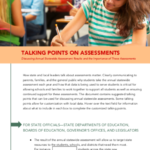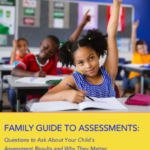Misinformation abounds when it comes to annual, summative assessments. Luckily, we’re here to set the record straight through our Essential Assessment Toolkit – the go-to guide for families, advocates, district and school leaders, and State Education Agencies. The below four resources are intended to support critical conversations on why students take an annual, summative assessment, why this assessment matters, and how districts and states can improve their assessment systems to better support student achievement.
Why do we need annual, summative assessments?
States administer an annual summative assessment to gauge how all students across the state are performing against the state’s academic standards. This assessment is the only one students take all year that produces information that can be compared across schools and districts in a state.
After two years of school closures and other disruptions caused by the pandemic, it’s more important than ever to have strong data about how students are performing academically.
Additionally, thanks to the Biden administration and congressional Democrats, states and districts have received roughly $122 billion from the American Rescue Plan in educational funding. This money has the potential to be transformational for students, but educational leaders need the information from state annual assessments to determine which students and schools are most in need of additional resources.
What’s in the Toolkit?
- FOR ADVOCATES & POLICYMAKERS: Addressing Common Concerns About Assessments provides advocates with a guide to discuss statewide annual assessments with policymakers, state and local education officials, educators, and parents and families, and helps address common misperceptions and myths about the annual state test.

- FOR STATE & DISTRICT LEADERS: Talking Points on Assessments is designed to provide state and local education and elected officials with key points they can use when discussing statewide annual assessments. Advocates should share these talking points with elected officials and education officials to better communicate the impact and importance of this assessment data for educators, families, and students.

- FOR DISTRICT & SCHOOL LEADERS: Guidance for Building a Balanced Assessment System is designed to help school and district leaders evaluate their assessment practices and ensure assessments are aligned with each other and state standards to maximizing instructional time and drive student learning. This piece of the toolkit also discusses the importance of access to data and educator training on how to use assessment data–both from the statewide annual assessment and other assessments administered throughout the year.

- FOR PARENTS & FAMILIES: Questions to Ask About Assessments is for advocates to share with parents and partner organizations that work directly with communities and families. This document provides families with key questions they can and should ask the teachers and administrators about their child’s assessment results, as well as the results of their school. Beyond providing these questions, the document provides important context about why these questions are important to ask and how to understand and respond to the answer they receive from their child’s school.

Taken together, this toolkit provides all stakeholders at the state and local level with key resources to increase their understanding of why state assessments are so important and how they can be used to improve the academic achievement of all students.
Can I share this toolkit?
Yes! This toolkit is intended to support families, educators, advocates, and policymakers to understand and explain the benefits of annual assessments.